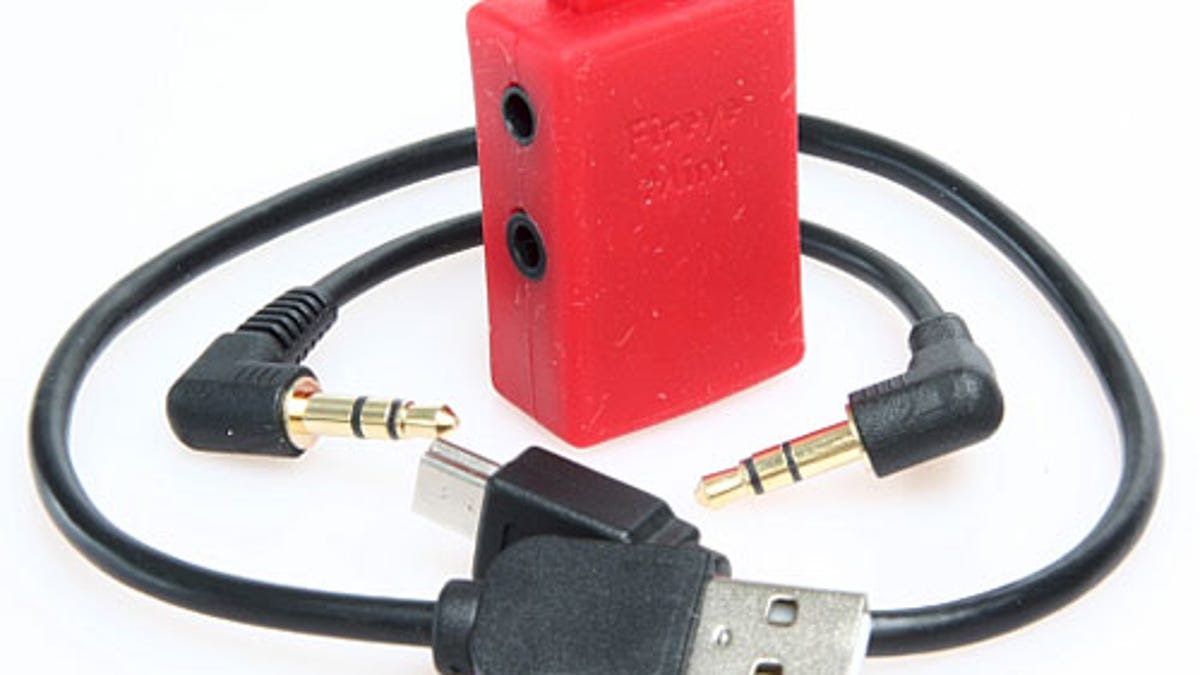 Why You Can Trust CNET
Why You Can Trust CNET Can a tiny $39 amp make your headphones sound a lot better?
The Audiophiliac listens to two outrageously fine Firestone products: the $199 Fireye DA USB headphone amp and the $39 Fireye Mini portable headphone amp.

Some "portable" headphone amplifiers aren't all that small, but the Firestone Audio Fireye Mini is downright tiny.
It's just 1.5 inches by 1 inch by 0.5 inch, and the soft-rubber-shelled amp weighs almost nothing, so you can hang it off your iPod, iPad, iPhone or any device with a 3.5mm headphone output. Plugging in a headphone turns the Mini on and lights a bright blue LED, unplugging turns the amp off. Charge the Mini via the USB connection and it'll play for up to 24 hours. It's available in green, gray, purple, red, and white.
The Mini is no giant-killer, but it definitely bumped up the detail and resolution of my Monster Turbine Copper, Ultimate Ears UE-4, and vPulse in-ear headphones. The Mini made each one sound like a better pair of headphones. Radiohead's "Amnesiac" had a more expansive soundstage, bass definition firmed up, and treble sparkle improved compared with what I get straight out of my iPod Classic. The amp's definitely worth $39, so if you've already invested in a nice set of headphones, why not see how good they can sound? Once I got used to having the Mini on my iPod the sound was drab without it. One caveat: your headphones' mic and phone controls won't work when plugged into the Mini; you can still hear the tunes, but that's all.
Measuring a still-compact 2.4 inches by 3.2 inches by 0.6 inch, the Fireye DA USB digital-to-analog converter/headphone amp ($199) isn't much bigger than the Mini. The machined metal chassis, volume control knob, and switches exude quality. The DA was designed to work with computers, but not with iPods/iPhones, etc. I used a Mac Mini as a music source for all of my listening tests.
The DA's sound has a solid foundation, so weighty bass impact is the star attraction here. Definition and punch are strong, and there's a bass boost switch on the front panel that adds even more kick to the low frequencies on my Audio-Technica ATH-M50 headphones.
The DA has two output jacks: a 3.5mm headphone jack and a 3.5mm line output/optical/digital. The front panel has bass boost and gain switches, while the second one pushes the volume level up for hard-to-drive headphones, like my 300-ohm Sennheiser HD 580s.
In direct comparisons with the Fiio E17 USB headphone amp ($139 on Amazon) with big orchestral scores punctuated with bass drums, both amps reached down to the deepest bass frequencies with ease, but the E17 sounded fuller and richer. The DA exerted greater control, so each drum hit was more distinct. The E17's warmth extended up through the midrange so strings sounded great, while the DA was leaner, but clearer-sounding. I was listening over the Audio-Technica ATH-M50 earphones, and switching over to the Sennheiser HD 580 headphones presented a very different sound, with a more distant perspective.
The HD 580s need more power than the M50s, but flicking the DA's high-gain switch fixed that problem. Even so, the Sennheiser sound was more laid-back and mellower than the M50s'. Classical and other types of acoustic music sound more realistic with the Sennheiser/DA combination than with the Audio-Technica. A quick switch over to the Fiio E17 was a bit of a letdown because the sound lacked the DA's resolution of fine detail. Amy Winehouse's music didn't change my feelings about both amps; the DA unleashed more of Winehouse's swagger and edge.
Finishing up with the Bowers & Wilkins P5 headphones, the E17 sounded veiled compared with the DA. I like both amps for different reasons. If you prefer warmth over detail, go for the E17; if you crave maximum resolution the DA would be a better choice.

